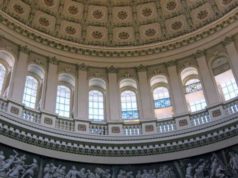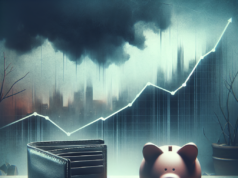In recent months, the United States has witnessed a notable surge in bankruptcy filings, signaling a troubling trend that reflects the broader economic turmoil affecting both businesses and individuals. As inflation rates soar and interest rates climb, many are finding it increasingly difficult to maintain financial stability. This article delves into the various factors contributing to this rise in bankruptcies, the demographics most affected, and the implications for the economy moving forward.
Understanding the Recent Surge in Bankruptcy Filings: An Overview of Economic Indicators
The recent surge in bankruptcy filings is a stark indicator of the economic challenges facing the nation. According to data from the American Bankruptcy Institute, filings have increased by over 30% compared to the previous year, marking one of the most significant spikes in a decade. This increase is not limited to corporate bankruptcies; personal filings have also risen sharply, suggesting a widespread financial strain on households. Economic indicators such as rising unemployment rates, stagnant wage growth, and declining consumer confidence further underscore the precarious financial landscape that many Americans are navigating. As these indicators paint a grim picture, the uptick in bankruptcy filings serves as a critical barometer of the overall health of the economy.
Key Factors Contributing to the Increase in Bankruptcy Filings Amid Economic Uncertainty
Several key factors are driving the increase in bankruptcy filings, with economic uncertainty at the forefront. The COVID-19 pandemic has left lasting scars on the economy, disrupting supply chains, altering consumer behavior, and leading to significant job losses. Additionally, the recent geopolitical tensions and ongoing trade disputes have exacerbated these issues, creating an environment of instability. Businesses, particularly small and medium-sized enterprises, are grappling with rising operational costs and shrinking profit margins. For individuals, the combination of stagnant wages and soaring living expenses has made it increasingly difficult to manage debt. As a result, many are turning to bankruptcy as a last resort to regain financial footing.
The Impact of Rising Inflation and Interest Rates on Business and Personal Bankruptcies
Rising inflation and interest rates have emerged as critical factors influencing the surge in bankruptcy filings. Inflation has reached levels not seen in decades, eroding purchasing power and increasing the cost of essential goods and services. This has placed immense pressure on both businesses and consumers, forcing many to make difficult financial decisions. Concurrently, the Federal Reserve’s decision to raise interest rates in an effort to combat inflation has further strained borrowers. Higher interest rates translate to increased costs for loans and credit, making it more challenging for individuals and businesses to service existing debts. Consequently, the combination of these economic pressures has led to a significant uptick in both business and personal bankruptcies.
Analyzing the Demographics: Who is Most Affected by the Surge in Bankruptcy Filings?
The demographic landscape of those affected by the surge in bankruptcy filings reveals a complex picture. While businesses across various sectors are struggling, certain industries, such as retail and hospitality, have been hit particularly hard due to changing consumer habits and lingering pandemic effects. On the personal side, low-income households and younger individuals are disproportionately affected, as they often lack the financial cushion to withstand economic shocks. Additionally, communities of color and marginalized groups are facing higher rates of bankruptcy filings, exacerbating existing inequalities. This demographic analysis highlights the urgent need for targeted support and resources to assist those most impacted by the economic downturn.
Legal Implications and Processes: Navigating Bankruptcy in Times of Economic Turmoil
Navigating the bankruptcy process can be daunting, particularly during times of economic turmoil. For businesses, Chapter 11 bankruptcy offers a pathway to restructure debts while continuing operations, but the process can be lengthy and complex. Individuals, on the other hand, may opt for Chapter 7 or Chapter 13 bankruptcy, each with its own implications for asset retention and debt repayment. Legal professionals emphasize the importance of understanding the nuances of each bankruptcy type and the potential long-term consequences on credit scores and financial futures. As the number of filings increases, so too does the demand for legal assistance, highlighting the critical role that bankruptcy attorneys play in guiding individuals and businesses through this challenging process.
Future Outlook: What the Surge in Bankruptcy Filings Means for the Economy Ahead
The surge in bankruptcy filings raises important questions about the future of the economy. While bankruptcy can provide a necessary reset for struggling businesses and individuals, widespread filings may also signal deeper systemic issues that require attention. Economists warn that if the trend continues, it could lead to a slowdown in consumer spending, further exacerbating economic challenges. Additionally, the potential for increased unemployment rates and reduced business investment could stifle economic recovery efforts. Policymakers will need to consider targeted interventions to support those affected and foster a more resilient economic environment. The road ahead remains uncertain, but the implications of this surge in bankruptcy filings will undoubtedly shape the economic landscape for years to come.
As the surge in bankruptcy filings continues to unfold, it serves as a critical reminder of the economic challenges facing many Americans. Understanding the underlying factors and demographics involved is essential for developing effective solutions to mitigate the impact of this trend. As we navigate these turbulent times, it is imperative that both individuals and policymakers work collaboratively to foster economic stability and support those in need. The future of the economy hinges on our collective ability to address these pressing issues head-on.





















